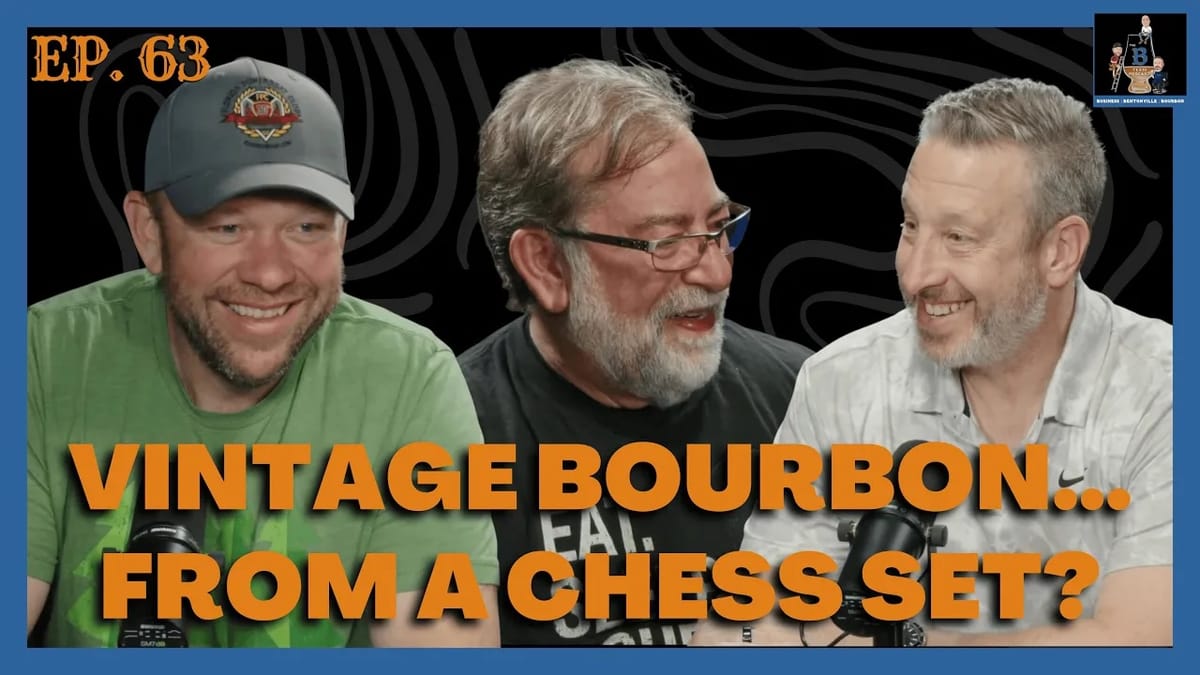Take a sip of liquid history as the B-Team dives deep into the forgotten world of vintage bourbon with special guest Stephen Mansfield (Instagram: @DustyWhiskeyHunter). What started as a casual conversation quickly transforms into a fascinating exploration of America's whiskey past through rare "dusties" – bourbon produced primarily before the 1960s that tastes remarkably different from modern spirits.
Stephen guides us through the post-Prohibition era when distilleries faced a surprising problem: too much aged bourbon and not enough buyers. As American drinkers shifted to vodka and clear spirits in the 50s and 60s, bourbon makers created elaborate decorative decanters – from chess pieces to figurines – marketed as collectibles rather than for their contents. Today, these forgotten vessels often contain liquid treasures that reveal how dramatically bourbon production has changed.
The highlight comes when Stephen shares his recent discovery of over 1,000 vintage decanters in an Arkansas collector's basement – six shelves high around every wall. As we sample an 8-year Lionstone and 10-year Old Crow from his collection, the differences from modern bourbon become immediately apparent: deeper mahogany colors, pronounced leather and tobacco notes, more minerality, and complex wood sugars that create unique tasting experiences.
But what exactly makes these dusties so distinctive? Stephen explains three key differences: less filtered water with natural minerals, barrels made from older trees with tighter growth rings, and proprietary yeast strains that distilleries once kept under lock and key. Together, these practices created bourbons with depth and character that modern production methods – focused on efficiency rather than maximizing flavor – simply can't replicate.
Whether you're a bourbon enthusiast, history buff, or simply curious about America's distilling heritage, this episode offers a rare glimpse into flavors and production methods largely lost to time. Subscribe to the B-Team Podcast and join us each week as we explore all things Bentonville, business, and bourbon!
More About this Episode
The Allure of Dusty Bourbon: Unlocking the Lost Art and Flavor of American Whiskey
In the age of artisanal everything - craft coffee, microbrews, single-origin chocolate - it’s no surprise that bourbon lovers are rediscovering one of the spirits world’s most overlooked treasures: dusty bourbon. On this episode of the B-Team Podcast, we dove headfirst into the fascinating universe of vintage whiskey with guest Stephen Mansfield, a passionate collector whose deep knowledge and love for the craft offered a masterclass in American whiskey history, production, and culture.
But let’s be clear: this isn't about kitsch or nostalgia for its own sake. Dusty bourbon represents a deeper, richer connection to a craft that has evolved, changed, and in many ways, lost some of its soul in the process.
What Is Dusty Bourbon?
The term “dusty” refers to whiskey - usually bourbon - that was bottled and shelved decades ago, often before modern manufacturing, marketing, and distribution processes reshaped the industry. While the general rule is that anything over 20 years old qualifies, the most sought-after dusties often date back to pre-1970s. These are not your run-of-the-mill bar shelf bourbons. We're talking about the hidden gems tucked away in basements, barns, estate sales, and forgotten liquor cabinets.
And Stephen? He's not just collecting these for the art of the decanters - although they’re certainly worth admiring - he’s in it for the liquid gold inside.
The Bourbon Glut: An Era of Surplus and Unexpected Riches
Much of what makes dusty bourbon so exceptional comes down to the unique historical moment in which it was produced. Post-Prohibition, the American whiskey industry surged, building inventory in anticipation of a booming market. But the 1950s and ‘60s ushered in a new era of consumer preferences - vodka, martinis, and “clear spirits” reigned supreme. Meanwhile, bourbon warehouses filled to the brim with unsold stock.
What happened next is legendary: brands like Jim Beam launched collectors clubs and began issuing ornate decanters to move product, advertising them as keepsakes rather than consumables. These decanters ended up sitting, untouched, for decades. The irony? Today, what was once a marketing gimmick has become a treasure trove of exceptionally aged and expertly made whiskey.
How Bourbon Production Has Changed Over the Decades
Stephen brought out several examples of dusty bourbon from his collection, and with each pour, we journeyed through a lost world of craftsmanship. One immediate difference: the depth of color. Compared to today's offerings, dusty bourbons often have a darker, richer hue - like Dr. Pepper without the fizz or red mahogany motor oil. But that’s just the beginning.
Oak and Aging
Barrel aging is one of the primary drivers of bourbon flavor, and it’s one of the clearest ways to tell dusty apart from modern whiskey. Back then, barrels were often made from older, slower-growing oak, which had denser grain patterns and richer sugars. Today’s younger wood lacks that same complexity. Combine that with slower, more traditional drying processes and you get a flavor that’s deeply oaky, rich in tannins, and layered with vanilla, leather, and spice.
Yeast and Water
Back in the day, most distilleries had proprietary yeast strains, carefully guarded and passed down like heirlooms. These imparted unique flavor profiles. Today, many operations use commercial yeast strains for consistency, but at the cost of character. Add to that the shift from natural limestone-rich spring water to heavily filtered sources, and it’s easy to see why modern bourbon can feel, well, less alive.
The Hunt for Dusty: A Modern-Day Whiskey Adventure
Stephen’s own journey into dusty bourbon collecting began in earnest around 2010. What started as a hobby turned into a passion, one that recently led him to one of the most impressive private collections in the country - over 1,000 vintage bourbon decanters, found via a Facebook ad.
The collection belonged to a deceased member of the now-defunct Jim Beam Razorback Collectors Club, and his home was a veritable time capsule: decanters lined floor-to-ceiling in a basement, some three and four deep on shelves, many still in their original packaging. As Stephen described walking into that basement, you could feel the reverence - a combination of shock, excitement, and awe. For bourbon enthusiasts, this was like stumbling upon a forgotten treasure chest.
Beyond the Bottle: Why Dusty Bourbon Matters
So why does dusty bourbon matter beyond its rarity?
Because it’s not just about nostalgia. These bottles represent a point in time when bourbon was still figuring out what it wanted to be - raw, unfiltered, experimental, and steeped in tradition. They weren’t yet shaped by market trends or optimized for scalability. They were made slowly, sometimes sloppily, but with heart. And that heart is missing from a lot of what we drink today.
These vintage bourbons also offer a sensory history lesson. The flavors - stone fruit, heavy oak, leather, and tobacco - tell a story. They speak of soil and tree rings, of basements and barns, of bootleggers and pharmacists. They are, quite literally, history in a glass.
Tasting Notes: A Trip Through Time
During the episode, we sampled a few standout decanters:
- Lionstone 8-Year, 86 Proof – A NDP (non-distilling producer) brand, Lionstone sourced from other distilleries, resulting in a spirit bursting with citrus and peach on the nose, and cedar and leather on the palate.
- Old Crow 10-Year, 86 Proof – Once the best-selling bourbon in America, Old Crow has fallen far from its former glory. But this vintage bottling was rich, leathery, and meaty, with flavors of burnt sugar and a powerful “Kentucky hug” finish.
We also learned how subtle changes in bottle storage - like being positioned in front of a basement heater or against a cool concrete wall - could affect evaporation and preservation over decades. These aren’t just bottles - they’re climate-sensitive relics.
Dusty's Renaissance: The New Market for Old Spirits
Interestingly, the dusty whiskey community has seen a rise in specialty bars that serve cocktails made exclusively with vintage spirits. There’s a growing demand in this niche, though the supply is obviously finite. Stephen hinted that we may be entering a new glut period, as bourbon production outpaces consumption once again. If history repeats, today’s surplus could become tomorrow’s dusty gold.
A Community Built on Passion
What ultimately emerged from our conversation was a sense of community. Whether it’s a Facebook post turning into a basement expedition or collectors sharing sips at tastings, the dusty bourbon world is held together by a deep appreciation for history, flavor, and craft. Stephen even invites enthusiasts to follow his journey on Instagram at @DustyWhiskeyHunter - an open call to explore the forgotten side of whiskey.
In a world chasing the next big thing, dusty bourbon reminds us of the beauty in looking back.
Whether you're a seasoned collector, a curious newcomer, or someone who simply enjoys a good pour, there's something special in these bottles that you can’t replicate with modern production. It’s more than just bourbon - it’s legacy, preserved one sealed decanter at a time.
Stay tuned for Part Two of our conversation with Stephen, where we dig even deeper into this living history and sample more of the rarest bourbons you’ll never find on a shelf today.


Member discussion: